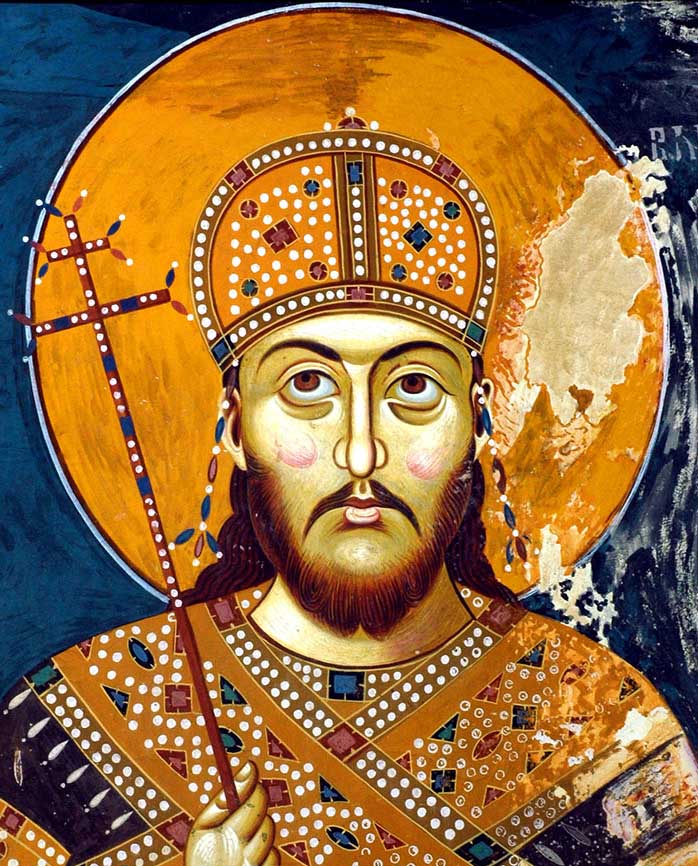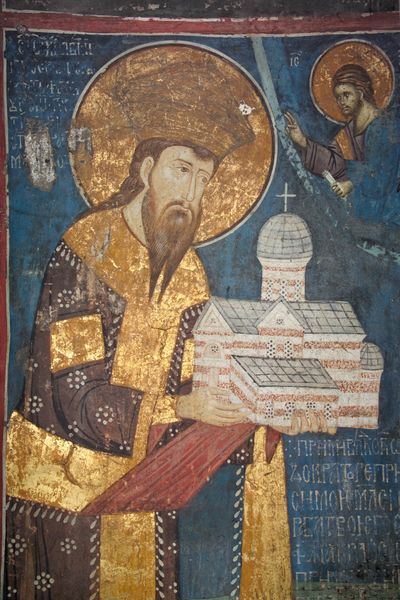|
Stefan Dušan
Stefan Uroš IV Dušan ( sr-Cyrl, Стефан Урош IV Душан, ), known as Dušan the Mighty ( sr, / ; circa 1308 – 20 December 1355), was the King of Serbia from 8 September 1331 and Tsar (or Emperor) and autocrat of the Serbs, Greeks (or Romans), Albanians and Bulgarians from 16 April 1346 until his death in 1355. Dušan conquered a large part of southeast Europe, becoming one of the most powerful monarchs of the era. Under Dušan's rule, Serbia was the major power in the Balkans, and an Eastern Orthodox multi-ethnic and multi-lingual empire that stretched from the Danube in the north to the Gulf of Corinth in the south, with its capital in Skopje. He enacted the constitution of the Serbian Empire, known as Dušan's Code, perhaps the most important literary work of medieval Serbia. Dušan promoted the Serbian Church from an archbishopric to a patriarchate, finished the construction of the Visoki Dečani Monastery (now a UNESCO site), and founded the monastery of ... [...More Info...] [...Related Items...] OR: [Wikipedia] [Google] [Baidu] |
Dušan's Code
Dušan's Code ( sr-cyr, Душанов законик, ''Dušanov zakonik'', known historically as ''Закон благовјернаго цара Стефана'' – Law of the pious Emperor Stefan) is a compilation of several legal systems that was enacted by Stefan Uroš IV Dušan of Serbia in 1349. It was used in the Serbian Empire and the succeeding Serbian Despotate. It is considered an early constitution, or close to it; an advanced set of laws which regulated all aspects of life. Background On 16 April 1346 (Easter), Dušan convoked a huge assembly at Skopje, attended by the Serbian Archbishop Joanikije II, the Archbishop of Ochrid Nikolaj I, the Bulgarian Patriarch Simeon and various religious leaders of Mount Athos. The assembly and clerics agreed on, and then ceremonially performed the raising of the autocephalous Serbian Archbishopric to the status of Serbian Patriarchate. The Archbishop from then on was titled Serbian Patriarch, although one document called him ... [...More Info...] [...Related Items...] OR: [Wikipedia] [Google] [Baidu] |
Nikodim I
Nikodim I of Peć and Nikodim of Hilandar ( sr, Никодим I Пећки) was a monk-scribe at Hilandar before becoming the 10th Serbian Archbishop from 1316 to 1324, he died in the year 1325. He is a Serbian saint and the Eastern Orthodox Church celebrates his feast day on May 11/24. Nikodim is the author of ''Rodoslov: srpskih kraljeva i vladika'' (The Lives of Serbian Kings and Bishops). Life In 1314, heir apparent Stefan Uroš III was exiled to Constantinople after quarrels with his father, king Stefan Milutin. In 1317, Uroš III asked Nikodim to intervene between him and his father. Nikodim's autobiographical note was inscribed in a manuscript entitled "A Visit to Constantinople" in the year 1318 and 1319. In 1320, Milutin allowed Uroš III to return upon the persuasion of Nikodim. Stefan Konstantin, Uroš's half-brother and heir to the throne, was crowned king upon the death of Milutin in 1321. Civil war erupted when Konstantin refused to submit to Uroš III, who then in ... [...More Info...] [...Related Items...] OR: [Wikipedia] [Google] [Baidu] |
Constantinople
la, Constantinopolis ota, قسطنطينيه , alternate_name = Byzantion (earlier Greek name), Nova Roma ("New Rome"), Miklagard/Miklagarth (Old Norse), Tsargrad ( Slavic), Qustantiniya (Arabic), Basileuousa ("Queen of Cities"), Megalopolis ("the Great City"), Πόλις ("the City"), Kostantiniyye or Konstantinopolis ( Turkish) , image = Byzantine Constantinople-en.png , alt = , caption = Map of Constantinople in the Byzantine period, corresponding to the modern-day Fatih district of Istanbul , map_type = Istanbul#Turkey Marmara#Turkey , map_alt = A map of Byzantine Istanbul. , map_size = 275 , map_caption = Constantinople was founded on the former site of the Greek colony of Byzantion, which today is known as Istanbul in Turkey. , coordinates = , location = Fatih, İstanbul, Turkey , region = Marmara Region , type = Imperial city , part_of = , length = , width ... [...More Info...] [...Related Items...] OR: [Wikipedia] [Google] [Baidu] |
Stefan Milutin
Stefan Uroš II Milutin ( sr-cyr, Стефан Урош II Милутин, Stefan Uroš II Milutin; 1253 – 29 October 1321), known as Stefan Milutin ( sr-cyr, Стефан Милутин, Stefan Milutin), was the King of Serbia between 1282–1321, a member of the Nemanjić dynasty. He was one of the most powerful rulers of Serbia in the Middle Ages. Milutin is credited with strongly resisting the efforts of Byzantine Emperor Michael VIII Palaiologos to impose Roman Catholicism on the Balkans after the Union of Lyons in 1274. During his reign, Serbian economic power grew rapidly, mostly due to the development of mining. He founded Novo Brdo, which became an internationally important silver mining site. As most of the Nemanjić monarchs, he was proclaimed a saint by the Serbian Orthodox Church with a feast day on October 30. Milutin appears in the Dante Alighieri's narrative poem ''Divine Comedy''. Early life He was the youngest son of King Stefan Uroš I and his wife, ... [...More Info...] [...Related Items...] OR: [Wikipedia] [Google] [Baidu] |
Stefan I Dusan Ktitorski Portret Decani2
Stefan may refer to: * Stefan (given name) * Stefan (surname) * Ștefan, a Romanian given name and a surname * Štefan, a Slavic given name and surname * Stefan (footballer) (born 1988), Brazilian footballer * Stefan Heym, pseudonym of German writer Helmut Flieg (1913–2001) * Stefan (honorific), a Serbian title * ''Stefan'' (album), a 1987 album by Dennis González See also * Stefan number, a dimensionless number used in heat transfer * Sveti Stefan Sveti Stefan ( Montenegrin and Serbian: Свети Стефан, ; lit. "Saint Stephen") is a town in Budva Municipality, on the Adriatic coast of Montenegro, approximately southeast of Budva. The town is known for the Aman Sveti Stefan resort, ... or Saint Stefan, a small islet in Montenegro * Stefanus (other) {{Disambiguation ... [...More Info...] [...Related Items...] OR: [Wikipedia] [Google] [Baidu] |
Eastern Orthodox Church
The Eastern Orthodox Church, also called the Orthodox Church, is the second-largest Christian church, with approximately 220 million baptized members. It operates as a communion of autocephalous churches, each governed by its bishops via local synods. The church has no central doctrinal or governmental authority analogous to the head of the Roman Catholic Church—the Pope—but the Ecumenical Patriarch of Constantinople is recognized by them as '' primus inter pares'' ("first among equals"), which may be explained as a representative of the church. As one of the oldest surviving religious institutions in the world, the Eastern Orthodox Church has played a prominent role in the history and culture of Eastern and Southeastern Europe. The Eastern Orthodox Church officially calls itself the Orthodox Catholic Church. Eastern Orthodox theology is based on holy tradition, which incorporates the dogmatic decrees of the seven ecumenical councils, the Scriptures, and the teachin ... [...More Info...] [...Related Items...] OR: [Wikipedia] [Google] [Baidu] |
Ottoman Empire
The Ottoman Empire, * ; is an archaic version. The definite article forms and were synonymous * and el, Оθωμανική Αυτοκρατορία, Othōmanikē Avtokratoria, label=none * info page on book at Martin Luther University) // CITED: p. 36 (PDF p. 38/338) also known as the Turkish Empire, was an empire that controlled much of Southeast Europe, Western Asia, and Northern Africa between the 14th and early 20th centuries. It was founded at the end of the 13th century in northwestern Anatolia in the town of Söğüt (modern-day Bilecik Province) by the Turkoman tribal leader Osman I. After 1354, the Ottomans crossed into Europe and, with the conquest of the Balkans, the Ottoman beylik was transformed into a transcontinental empire. The Ottomans ended the Byzantine Empire with the conquest of Constantinople in 1453 by Mehmed the Conqueror. Under the reign of Suleiman the Magnificent, the Ottoman Empire marked the peak of its power and prosperity, as well a ... [...More Info...] [...Related Items...] OR: [Wikipedia] [Google] [Baidu] |
Monastery Of The Holy Archangels
The Monastery of the Holy Archangels ( sr, Манастир Светих Архангела, Manastir Svetih Arhangela; al, Manastiri i Arkangjelit të Shenjtë) is a Serbian Orthodox monastery located in Prizren, Kosovo. The monastery was founded by the Serbian Emperor Stefan Dušan (reigned 1331–1355) between 1343 and 1352 on the site of an earlier church, part of the Višegrad fortress complex. It was the burial church for Emperor Dušan, and represented the culmination of the Serbian ecclesiastical architectural style, that led to the birth of the Morava school style. The complex, which ranges over 6,500 m², includes two churches, the main one is dedicated to the Holy Archangels (where Dušan's tomb lied), and the second one is dedicated to St. Nicholas, both built in the Rascian architectural style. The monastery was looted and destroyed after the Ottomans arrived in 1455, and in 1615 it was razed to the ground and its material was used for the construction of the S ... [...More Info...] [...Related Items...] OR: [Wikipedia] [Google] [Baidu] |
Medieval Monuments In Kosovo
The Medieval Monuments in Kosovo ( sr, Средњовековни споменици на Косову, Srednjovekovni spomenici na Kosovu; ) are a World Heritage Site consisting of four Serbian Orthodox Christian churches and monasteries which represent the fusion of the eastern Orthodox Byzantine and the western Romanesque ecclesiastical architecture to form the Palaiologian Renaissance style. The construction was founded by members of Nemanjić dynasty, the most important dynasty of Serbia in the Middle Ages. The sites are located in the modern-day Kosovo. In 2004, UNESCO recognized the Dečani Monastery for its outstanding universal value. Two years later, the site of patrimony was extended as a serial nomination, to include three other religious monuments: Patriarchate of Peć Monastery, Our Lady of Ljeviš and Gračanica Monastery. In 2006 the property was inscribed on the list of World Heritage in Danger due to difficulties in its management and conservation stemming ... [...More Info...] [...Related Items...] OR: [Wikipedia] [Google] [Baidu] |
Visoki Dečani
The Visoki Dečani Monastery ( sr, Манастир Високи Дечани, Manastir Visoki Dečani, sq, Manastiri i Deçanit) is a medieval Serbian Orthodox Christian monastery located near Deçan, Kosovo. It was founded in the first half of the 14th century by Stefan Dečanski, King of Serbia. The Visoki Dečani monastery is located by the Deçan's Lumbardh river gorge at the foot of the Accursed Mountains, in the region of Metohija. It is located about from the town of Deçan. The monastery is managed by the Serbian Orthodox Eparchy of Raška and Prizren. The monastery has been under the legal protection of Serbia since 1947 with a designation of ''Cultural Monument of Exceptional Importance''. The monastery is part of the World Heritage site named " Medieval Monuments in Kosovo". History Construction began during the reign of Serbian King Stefan Dečanski in 1327 and the original founding charter from 1330 has been preserved. Dečanski's son, Stefan Dušan, seized the ... [...More Info...] [...Related Items...] OR: [Wikipedia] [Google] [Baidu] |
Serbian Patriarchate Of Peć
The Serbian Patriarchate of Peć ( sr, Српска патријаршија у Пећи, ''Srpska patrijaršija u Peći'') or just Patriarchate of Peć ( sr, Пећка патријаршија, ''Pećka patrijaršija''), was an autocephaly, autocephalous Eastern Orthodox Patriarchate that existed from 1346 to 1463, and then again from 1557 to 1766 with its seat in the Patriarchal Monastery of Peć. It had ecclesiastical jurisdiction over Eastern Orthodox Christians in Serbian Lands and other western regions of Southeastern Europe. Primates of the Patriarchate were styled ''Archbishop of Peć and Serbian Patriarch''. Medieval Period (1346–1463) Since 1219, the Eastern Orthodox Church in the medieval Kingdom of Serbia (medieval), Kingdom of Serbia was organized as an autocephaly, autocephalous Archbishopric seated at first in the Monastery of Žiča and since the middle of the 13th century in the Patriarchal Monastery of Peć, Monastery of Peć. Political expansion of the Ser ... [...More Info...] [...Related Items...] OR: [Wikipedia] [Google] [Baidu] |







